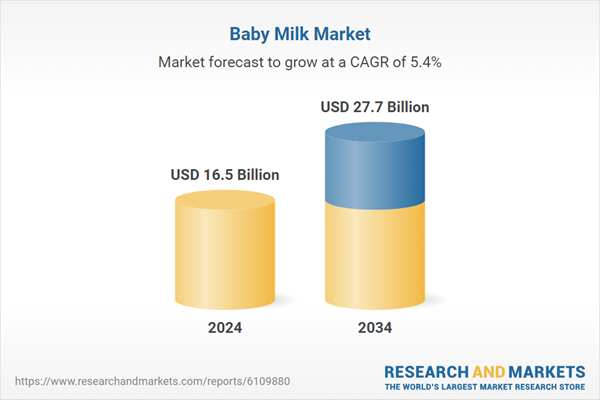Evolving consumer preferences are reshaping the baby milk category, pushing companies to deliver safe, efficient, and nutrient-rich options that align with health-conscious parenting. Today’s caregivers are not only looking for basic nutrition but are increasingly concerned about product transparency, clean labels, organic sourcing, and the absence of artificial additives. This shift has led manufacturers to reformulate offerings with non-GMO ingredients, probiotics for gut health, and formulas tailored to specific needs such as lactose intolerance, allergies, or premature birth. Parents are now more informed and demand products backed by clinical research and medical endorsements.
The infant formula segment held a 40.2% share in 2024 and is anticipated to maintain its leadership, growing at a CAGR of 5.6% through 2034. Parents rely heavily on this segment during the initial six months of life when infants are most vulnerable and need a carefully balanced nutritional solution. These formulas are crafted to deliver complete nourishment, closely mimicking the key nutrients found in breast milk. With health awareness rising among caregivers, demand for high-quality and medically approved infant formula remains a strong driver for the category, especially in urban households.
The carbohydrates segment held a 28.1% share in 2024 and is projected to rise at a 5.5% CAGR by 2034. Lactose, the primary carbohydrate in most baby milk formulas, serves as a critical energy source and supports vital functions such as brain development and healthy gut flora. It also plays a role in enhancing calcium absorption and promoting skeletal development. While other ingredients such as proteins, vitamins, fats, and prebiotics are essential for immune defense, metabolic function, and tissue repair, carbohydrates remain central due to their foundational contribution to infant growth. Their synergistic effect with other nutrients underscores their continued prominence in product formulations.
United States Baby Milk Market generated USD 3.9 billion in 2024 and is projected to grow at a 4.4% CAGR by 2034. The U.S. benefits from a mature formula manufacturing sector, wide-scale product accessibility, and a highly informed consumer base. Demand remains consistently high for both standard and specialized formulas, driven by evolving dietary needs and strong product availability. The presence of established players such as Abbott Laboratories, Nestlé, and Mead Johnson (Reckitt) continues to influence innovation cycles and supply chain strength, making the U.S. a cornerstone of the baby milk industry in the region.
Key companies shaping the Global Baby Milk Market include Abbott Laboratories, Arla Foods Amba, Bellamy's Organic, Biostime (H&H Group), and Ausnutria Dairy Corporation Ltd. To reinforce their position, leading players in the baby milk sector are leveraging strategies that focus on product innovation, regulatory alignment, and consumer education. Many are investing in R&D to introduce formulations fortified with probiotics, organic ingredients, and allergen-free components. Companies are also working to expand their distribution reach by strengthening partnerships with e-commerce platforms, pharmacies, and healthcare networks. Sustainability initiatives around packaging and clean-label certifications have become key differentiators, especially among health-conscious parents.
Comprehensive Market Analysis and Forecast
- Industry trends, key growth drivers, challenges, future opportunities, and regulatory landscape
- Competitive landscape with Porter’s Five Forces and PESTEL analysis
- Market size, segmentation, and regional forecasts
- In-depth company profiles, business strategies, financial insights, and SWOT analysis
This product will be delivered within 2-4 business days.
Table of Contents
Companies Mentioned
- Arla Foods amba
- Ausnutria Dairy Corporation Ltd.
- Abbott Laboratories
- Bellamy's Organic
- Biostime (H&H Group)
- Bobbie
- Bubs Australia Limited
- ByHeart
- China Feihe Limited
- Danone S.A.
- FrieslandCampina N.V.
- Hipp GmbH & Co. Vertrieb KG
- Holle Baby Food AG
- Kendamil
- Mengniu Dairy
- Morinaga Milk Industry Co., Ltd.
- Nestlé S.A.
- Perrigo Company plc
- Reckitt Benckiser Group plc (Mead Johnson)
- Yili Group
Table Information
| Report Attribute | Details |
|---|---|
| No. of Pages | 245 |
| Published | June 2025 |
| Forecast Period | 2024 - 2034 |
| Estimated Market Value ( USD | $ 16.5 Billion |
| Forecasted Market Value ( USD | $ 27.7 Billion |
| Compound Annual Growth Rate | 5.4% |
| Regions Covered | Global |
| No. of Companies Mentioned | 20 |









